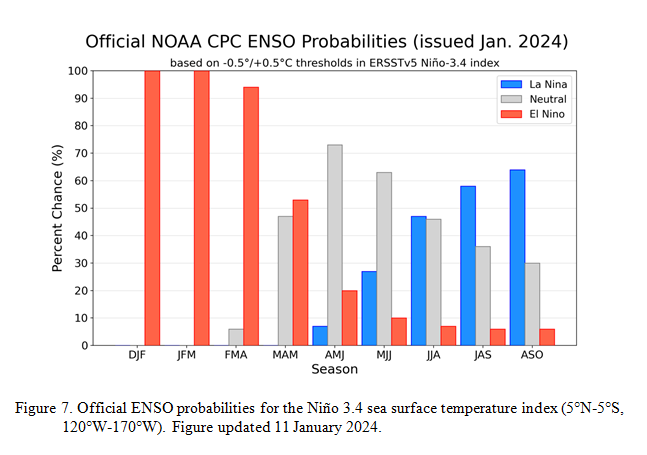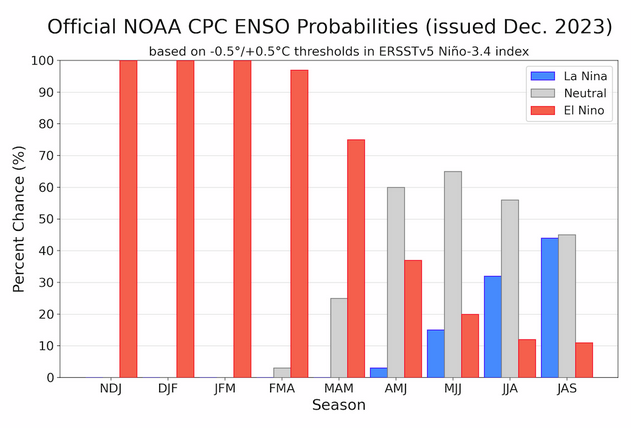NOAA Updates its ENSO Alert on January 11, 2024 – The El Nino Advisory Continues. Disagreement on When it Will End
On the second Thursday of every month, NOAA (really their Climate Prediction Center CPC) issues its analysis of the status of ENSO. This includes determining the Alert System Status. NOAA again describes their conclusion as “ENSO Alert System Status: El Nino Advisory”
There is not much doubt that we have an El Nino. How long it lasts and its strength remains to be seen. This El Nino has not become a Historical El Nino. We will try to address the slight confusion of when the El Nino will end in this article.
We have included some very interesting graphics from and a link to an interesting ENSO Blog article by Emily Becker.
CLIMATE PREDICTION CENTER ENSO DISCUSSION

| The second paragraph is what is important:
“The most recent IRI plume indicates El Niño will gradually weaken and then transition to ENSO-neutral during spring 2024 . Some state-of the-art dynamical climate models suggest a transition to ENSO-neutral as soon as March-May 2024. The forecast team, however, delays this timing and strongly favors a transition to ENSO-neutral in April-June 2024. There are also increasing odds of La Niña in the seasons following a shift to ENSO-neutral. It is typical for El Niño to peak in December/early January, but despite weakening, its impacts on the United States could last through April (see CPC seasonal outlooks for probabilities of temperature and precipitation). In summary, El Niño is expected to continue for the next several seasons, with ENSO-neutral favored during April-June 2024 (73% chance). Below is the middle paragraph from the discussion last month. ” The most recent IRI plume favors El Niño to continue through the Northern Hemisphere winter 2023-24. Based on the latest forecasts, there is now a 54% chance of a “historically strong” El Niño during the November-January season (³ 2.0°C in Niño-3.4). An event of this strength would potentially be in the top 5 of El Niño events since 1950. While stronger El Niño events increase the likelihood of El Niño-related climate anomalies, it does not imply expected impacts will emerge in all locations or be of strong intensity (see CPC seasonal outlooks for probabilities of temperature and precipitation). In summary, El Niño is expected to continue through the Northern Hemisphere winter, with a transition to ENSO-neutral favored during April-June 2024 (60% chance;).” |
We now provide additional detail. The level of uncertainty with respect to how this El Nino will play out has increased quite a bit.
CPC Probability Distribution
Here are the new forecast probabilities. The probabilities are for three-month periods e.g. DJF stands for December/January/February.
Here is the current release of the probabilities:

| This chart shows the forecasted progression of the evolution of ENSO from the current El Nino State to Neutral and by the summer to La Nina. |
Here is the forecast from late last month.
| The analysis this month and last month are different. This month the probability of El Nino in MAM is much less than was expected last month. That is important. |


